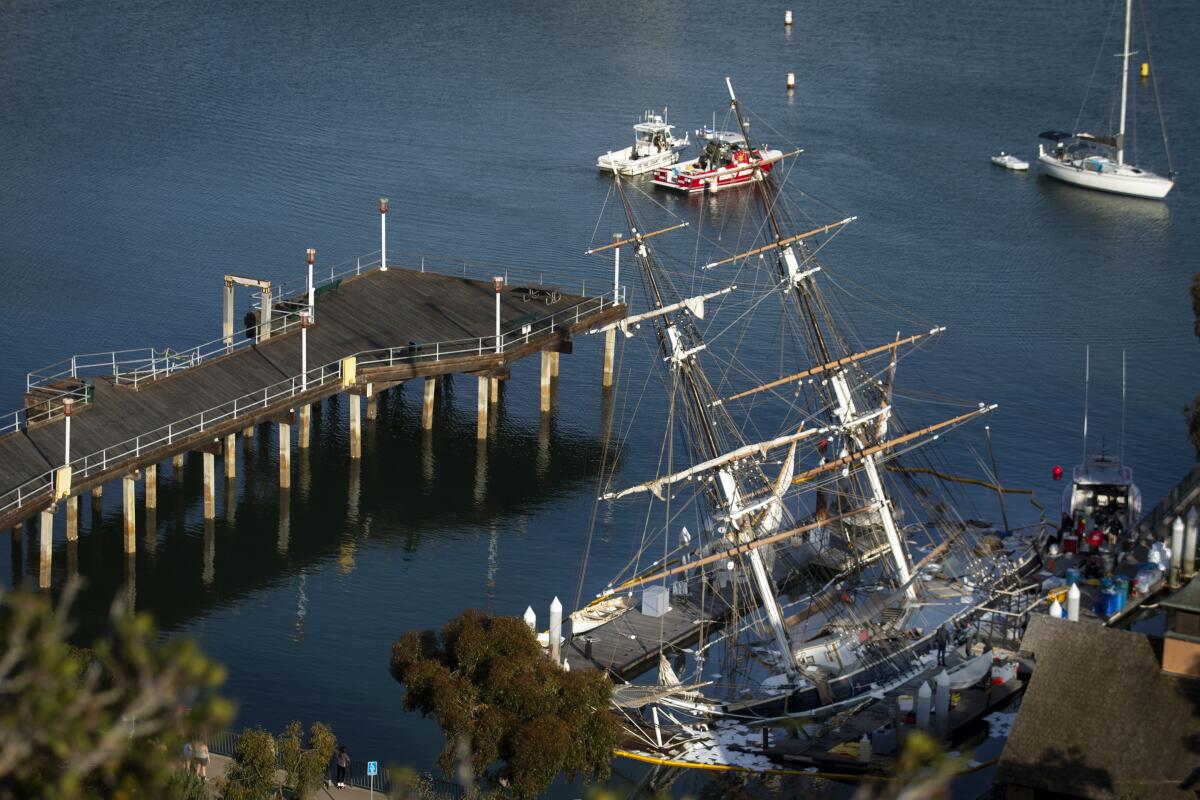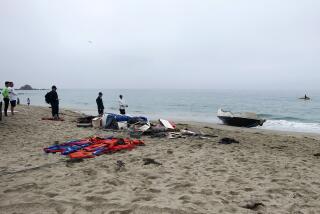Replica ship Pilgrim, longtime SoCal field-trip destination, sinks in Dana Point Harbor

- Share via
One of the first times the replica ship Pilgrim was mentioned in the Los Angeles Times, it was under the headline “Vagabond Youth.”
It was 1974, and a group of young Southern Californians had answered an ad in the paper from Capt. Ray Wallace, who offered them the experience of a lifetime if they’d pay $1,000 and fly overseas to help him on a boating trip from the Spanish and Portuguese coast all the way back to Monterey — maritime experience recommended but not necessary.
Though the journey was a one-off for the Pilgrim and its crew, the vessel and that trans-Atlantic trip imbued all who spent time on it with a classic sense of adventure.
But after nearly 40 years anchored in in Orange County’s Dana Point Harbor, where hundreds of thousands of kids since 1981 have toured the vessel and spent overnight field trips on it, the adventure is over, at least for now.
For reasons still unclear, the vessel began taking on water sometime over the weekend and keeled over Sunday morning, its hull partially submerged in about 10 feet of water and leaning to one side.
The boat is so old and fragile that its current owner, Dana Point nonprofit the Ocean Institute, isn’t sure it will be able to save the vessel. Workers spent Sunday evening ensuring that no hazardous materials leaked into the harbor and stabilizing the boat so it could be floated and the hull inspected, said Wendy Marshall, president of education and operations at the Ocean Institute.
Since news of the capsizing spread Sunday, Marshall and others have been flooded with emails, phone calls and text messages of support from past visitors to the Pilgrim, she said. One man, who works in marketing, told Marshall that he hadn’t really tapped into his creative side as a kid until, on a Pilgrim field trip, he was assigned watch for two hours and had to figure out how to describe the nothingness that is night-watch duty on the ocean.
“Honestly, the memories are going to be the hardest thing to replace, and the authenticity of the quarters,” Marshall said. “You just don’t buy this on Amazon.”
The original Pilgrim was built in the 1830s and was immortalized by one of its seamen, Richard Henry Dana Jr., in the book “Two Years Before the Mast,” which documented the ship’s trading route between Boston and Los Angeles.
Back then, the vessel traded California cow hides in New England and returned to the West Coast with furniture after a perilous, yearlong trip that rounded Cape Horn, said Bill Steel, 62, whose uncle built the Pilgrim replica.
More than a century later, Steel said, entrepreneurs in Monterey had the idea of creating a small maritime tourist and school destination out of a replica boat and reached out to Steel’s uncle, Ray Wallace, to build it. Wallace also built Disneyland’s Sailing Ship Columbia.
Wallace flew to Denmark, Steel said, where he found a wooden hull roughly the size of the one described in Dana’s book. He brought the hull south to be completed by shipbuilders in Portugal, where he was anchored in April 1974 when the Carnation Revolution overthrew the Estado Novo authoritarian regime.
Wallace suddenly found himself in hostile waters and was detained, his nephew said. Using cunning — and liquor — he plied a guard and made his escape to the Canary Islands. There he came up with the idea for an ad in American newspapers offering an adventure for a novice crew that would help him finish the trip — and fund it.
The resulting journey and the crew’s arrival in Southern California were reported by newspapers nationwide, including The Times. After carrying other locals on trips to coastal islands and down to Mexico, the Pilgrim replica permanently anchored in Orange County’s Dana Point Harbor, named for the original Pilgrim sailor, in 1981.
“This is probably the end of the line for the Pilgrim, and I’m really sad to say that,” Steel said. “But I think it’s an opportunity for all the people who have ever been on the Pilgrim to rally, to show their support ... because it’s kind of a symbol of what we’re really going through as a society. It really couldn’t have come at a worse time.”
Even if the vessel can’t be saved, Marshall said, workers hope to salvage the boat’s rigging and other portions that could be restored for future use. In the meantime, the institute will lean on its two other ships for educating local children, though neither has the Pilgrim’s captivating history.
More to Read
Sign up for Essential California
The most important California stories and recommendations in your inbox every morning.
You may occasionally receive promotional content from the Los Angeles Times.











